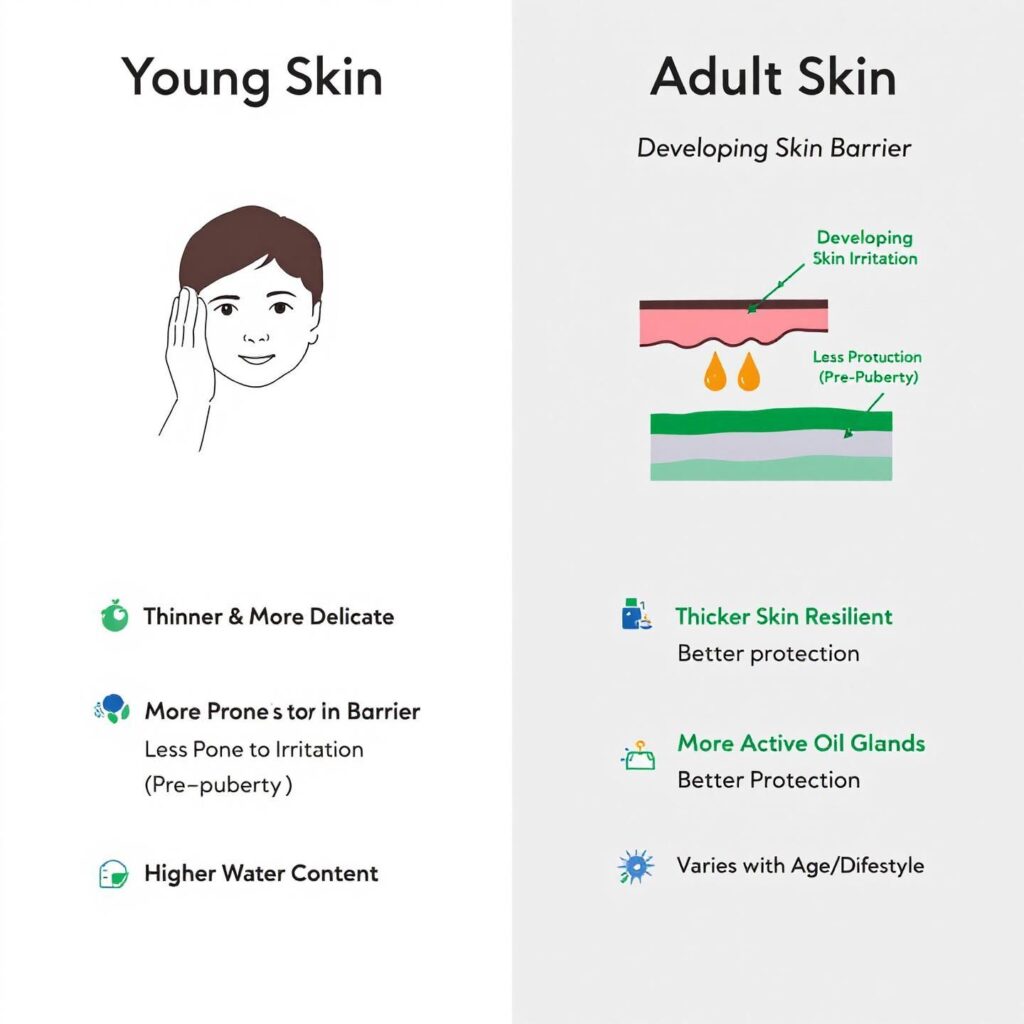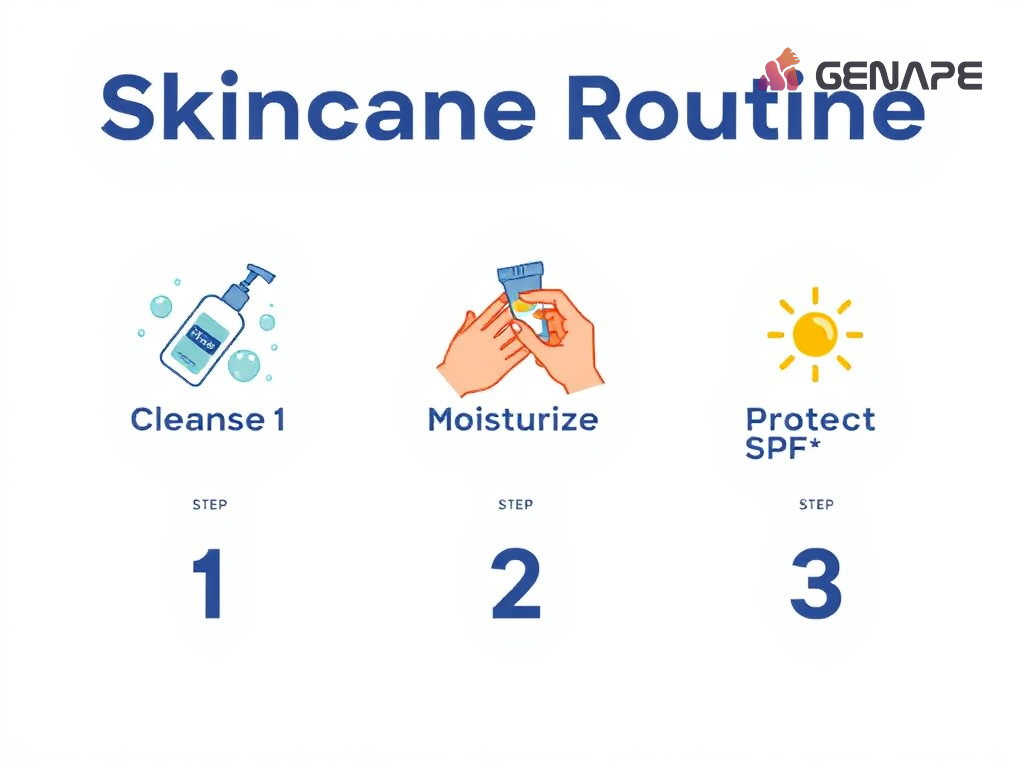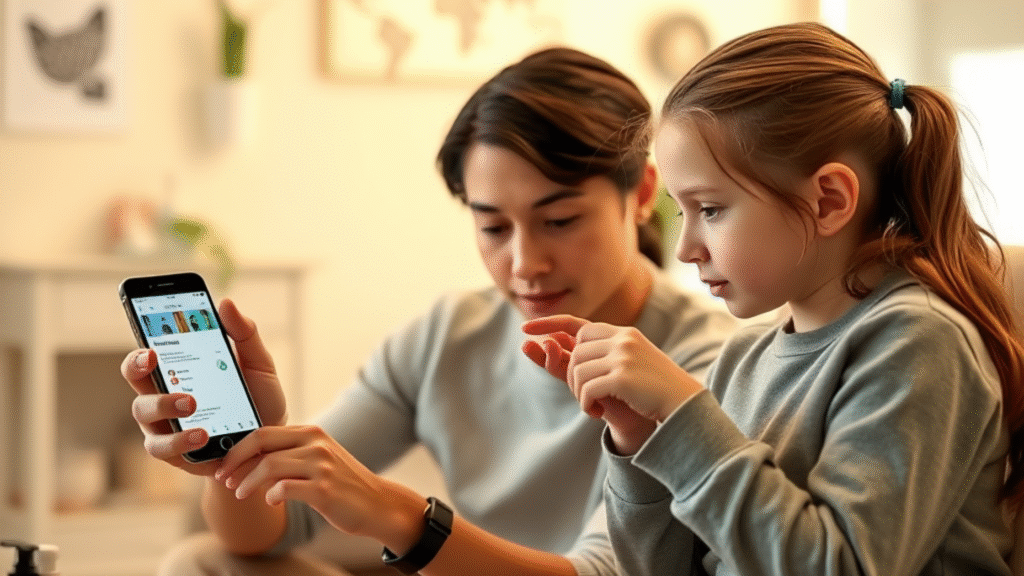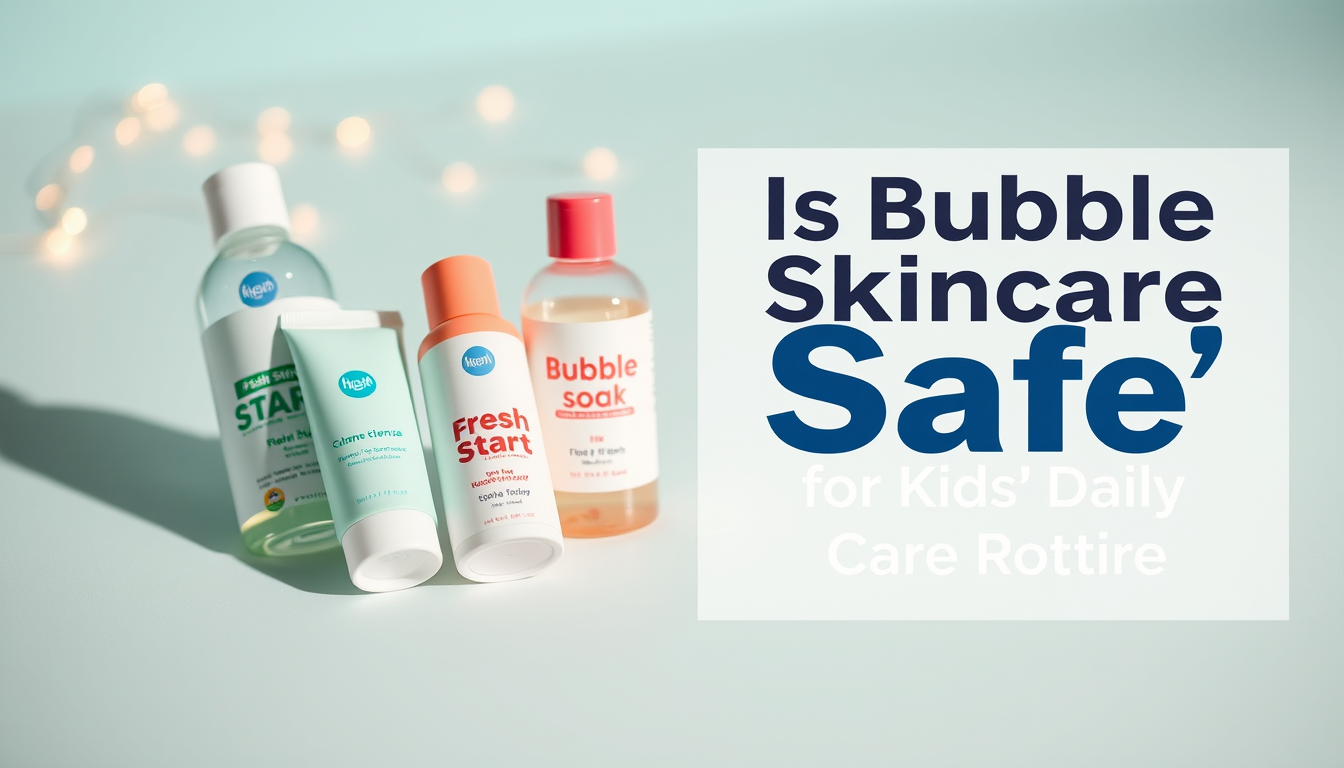Bubble Skincare has taken the beauty world by storm, especially among young people. With its bright, colorful packaging and social media buzz, it’s easy to see why kids and teens are drawn to it. But as a parent or guardian, you might be wondering: Is Bubble Skincare good for kids daily skin care routine? 🤔
Young skin is different from adult skin. It’s more delicate and still developing, which means it needs different care. This article will help you understand Bubble Skincare, its ingredients, and how to decide if it’s the right choice for the young people in your life. We’ll explore what makes young skin unique, what ingredients to look for, and how to build a simple, safe routine. Let’s dive in!
Key Takeaways
- Young Skin is Different: Kids’ skin is thinner, more sensitive, and its protective barrier is still developing, making it more prone to irritation from harsh products.
- Bubble Products Vary: While some Bubble products are gentle and suitable for young skin, others contain active ingredients (like strong acids or retinoids) that are better suited for adult skin concerns.
- Focus on Simplicity: For most kids, a basic routine of a gentle cleanser, a good moisturizer, and sunscreen is all that’s needed.
- Read Ingredients Carefully: Always check product labels for ingredients that might be too strong or irritating for young, sensitive skin, such as harsh exfoliants, strong fragrances, or high concentrations of active ingredients.
- Consult a Professional: If your child has specific skin concerns like acne, eczema, or very sensitive skin, it’s always best to talk to a dermatologist before introducing new products.

What is Bubble Skincare?
Bubble Skincare is a popular brand known for its eye-catching packaging and products designed for a younger audience, particularly teenagers and young adults. The brand’s philosophy often centers around clean, effective ingredients and a fun, accessible approach to skincare. They offer a wide range of products, including cleansers, moisturizers, serums, and masks, targeting common skin concerns like acne, dryness, and dullness.
Bubble has gained a massive following through social media platforms like TikTok and Instagram. This digital presence has made it a household name among Gen Z, turning skincare into a trendy, almost collectible hobby.
The brand often highlights its “skin-friendly” ingredients, promising formulas that are free from common irritants like parabens, sulfates, and synthetic dyes. They also emphasize their vegan and cruelty-free status, which appeals to many conscious consumers.
Why is it so popular with kids and teens?
- Cool Packaging: The bright colors and unique shapes of Bubble bottles and tubes are very appealing. They look great on bathroom shelves and in social media posts.
- Social Media Buzz: Influencers and friends often share their Bubble routines online, making it seem like a must-have. When everyone else has it, kids want it too!
- Targeted Marketing: Bubble directly speaks to the concerns and interests of young people, making them feel understood.
- Accessibility: The products are often available in popular drugstores and online, making them easy to get.
- “Glow Up” Culture: There’s a big trend among young people to improve their appearance and feel confident, and skincare is a big part of that.
While the popularity is undeniable, the real question remains: Are these products truly good for young, developing skin?
Understanding Young Skin: Why It’s Different
Before we dive into Bubble’s ingredients, it’s super important to understand that a child’s skin is NOT the same as an adult’s. Think of it like a young plant versus a fully grown tree – both need care, but in different ways.
Here’s why young skin needs special attention:
- Thinner and More Delicate: A child’s skin layers are thinner than an adult’s. This means it’s more easily damaged and more sensitive to things applied to it.
- Developing Skin Barrier: The skin barrier is like your body’s shield. It keeps good things (like moisture) in and bad things (like germs and irritants) out. In kids, this barrier is still developing and isn’t as strong or mature as an adult’s. A weaker barrier means skin can get dry or irritated more easily.
- More Prone to Irritation: Because it’s thinner and the barrier is weaker, young skin reacts more strongly to harsh chemicals, fragrances, and strong active ingredients. What might be fine for an adult could cause redness, itching, or breakouts on a child.
- Different Oil Production: Before puberty, kids generally have less oil production. This means their skin is less prone to adult-like acne but can be more prone to dryness. During puberty, oil glands become more active, which can lead to breakouts, but even then, harsh treatments can do more harm than good.
- Higher Water Content: Young skin has a higher water content, making it appear plump and smooth. However, it also loses water more quickly, making hydration important.
It’s clear that a “less is more” approach is usually best for young skin. Overloading it with too many products or strong ingredients can disrupt its natural balance and lead to problems down the road.

Common Skincare Ingredients and Their Impact on Young Skin
When looking at any skincare product, it’s all about the ingredients! Here’s a quick guide to common ingredients and how they might affect young skin:
Generally Safe & Beneficial Ingredients for Kids:
These ingredients are usually gentle and help support healthy skin.
- Glycerin: A humectant, meaning it draws moisture from the air into the skin. It’s very hydrating and gentle.
- Hyaluronic Acid (HA): Another powerful humectant that helps skin hold onto water, keeping it plump and hydrated. In low concentrations, it’s great for young skin.
- Ceramides: These are natural fats found in the skin barrier. Adding ceramides helps strengthen the skin’s protective shield, reducing dryness and irritation.
- Niacinamide (Vitamin B3): A multi-tasking ingredient that can help calm redness, reduce inflammation, and improve the skin barrier. In lower percentages (1-5%), it’s generally safe for teens and pre-teens.
- Gentle Plant Extracts: Ingredients like green tea extract, chamomile, or aloe vera can offer soothing properties without being irritating.
- Squalane: A very gentle emollient that mimics the skin’s natural oils, providing moisture without feeling heavy or greasy.
- Mineral Sunscreen Ingredients (Zinc Oxide, Titanium Dioxide): These are physical blockers that sit on top of the skin and reflect UV rays. They are generally considered the safest and least irritating sun protection for kids.
Potentially Problematic Ingredients for Young Skin:
These are ingredients that young skin might react poorly to, or that are simply not needed.
- Strong Acids (AHAs like Glycolic Acid, Lactic Acid; BHAs like Salicylic Acid in high concentrations): These are exfoliants that can be too harsh for thin, developing skin. While low concentrations of salicylic acid (0.5-1%) might be okay for targeted acne spots on teens, daily all-over use can be too much.
- Retinoids (Retinol, Tretinoin): Powerful anti-aging and acne-fighting ingredients that speed up cell turnover. They can cause dryness, redness, and sensitivity, and are generally not recommended for young skin unless prescribed by a dermatologist for severe acne.
- Harsh Physical Exfoliants: Scrubs with large, rough particles (like apricot pits or walnut shells) can create tiny tears in the delicate skin barrier, leading to irritation and inflammation.
- Strong Fragrances (Parfum/Fragrance): While they make products smell nice, synthetic fragrances are a common cause of skin allergies and irritation, especially for sensitive young skin. Look for “fragrance-free” products.
- Essential Oils: Though natural, many essential oils can be highly irritating and allergenic when applied to the skin, particularly for sensitive individuals.
- Sulfates (SLS, SLES): Often found in foaming cleansers, these can strip the skin of its natural oils, leading to dryness and irritation.
- Denatured Alcohol: Can be very drying and irritating to the skin.
Bubble Skincare: A Deep Dive into Key Products and Ingredients
Now, let’s look at some common Bubble products and analyze their ingredients based on what we’ve learned about young skin.
Bubble offers a range of products, and their suitability depends on the specific product and the child’s skin needs. It’s not a one-size-fits-all answer!
Bubble Products Generally Considered Gentle (and potentially good for kids):
- Fresh Start Gel Cleanser: This cleanser is designed to be gentle and non-stripping. It contains ingredients like purified water, coco-glucoside (a mild cleanser), and glycerin. It’s generally a good choice for daily cleansing for most skin types, including young skin.
- Our Take: 👍 Good for basic cleansing.
- Slam Dunk Hydrating Moisturizer: This moisturizer aims to provide hydration without being heavy. It often contains ingredients like aloe leaf juice, glycerin, squalane, and vitamin E. These are all generally safe and beneficial for maintaining skin hydration.
- Our Take: 👍 Excellent for daily moisture.
- Level Up Balancing Moisturizer: Similar to Slam Dunk but often formulated with ingredients to help balance oil, like niacinamide (often in lower percentages). If the niacinamide percentage is low (1-2%), it can be suitable for pre-teens or teens with slightly oily skin.
- Our Take: 👍 Good for slightly oily or combination skin, check niacinamide percentage.
Bubble Products Requiring Caution or Not Recommended for Young Skin:
Some Bubble products contain active ingredients that, while effective for certain adult skin concerns, might be too strong or unnecessary for young, developing skin.
- Wipe Out Purifying Mask: This mask often contains clay and salicylic acid. While salicylic acid can be good for acne, using a mask with it too often or on sensitive young skin can be drying or irritating.
- Our Take: ⚠️ Use with caution, maybe once a week for targeted areas on teens with mild acne, not for general use.
- Super Clear Serum (with 2% Salicylic Acid): A 2% concentration of salicylic acid is a common strength for adult acne treatments. For many young kids or pre-teens, this might be too strong for daily all-over use and could cause dryness or irritation. It’s best reserved for older teens with persistent acne, and even then, only for targeted spots or specific dermatologist recommendations.
- Our Take: ⛔ Generally not recommended for pre-teens or young kids. For teens, use only if needed for acne and with caution.
- Fade Away Serum (with Niacinamide and Tranexamic Acid): While niacinamide is generally good, tranexamic acid is often used for hyperpigmentation (dark spots), which is less common and usually not a primary concern for young skin. This serum is likely unnecessary for most kids.
- Our Take: ⛔ Unnecessary for most young skin.
- Moon Walk Gentle Exfoliating Serum (with AHAs): Contains alpha hydroxy acids (AHAs) like lactic acid. While it’s marketed as “gentle,” any AHA can be too much for developing skin, especially if used regularly. Exfoliation should be minimal or avoided for younger children.
- Our Take: ⛔ Not recommended for young skin.
The Golden Rule: If a product focuses on “active” ingredients like strong acids, retinoids, or intense exfoliation, it’s usually best to avoid it for children and pre-teens. Their skin doesn’t need these treatments and can be harmed by them.
When is Bubble Skincare Appropriate for Kids?
Bubble Skincare can be appropriate for kids and pre-teens, but only with careful selection and understanding.
Good for Basic Care (Cleanse, Moisturize, Protect):
- Pre-teens (ages 9-12) and early teens (13-15) with normal skin: For those who are starting to show interest in skincare or need a basic routine.
- Focus on gentle products: The Fresh Start Cleanser and Slam Dunk Moisturizer are excellent choices for a simple, daily routine. These focus on cleansing without stripping and hydrating without clogging.
- Addressing Mild Dryness: The Slam Dunk moisturizer is great for keeping skin hydrated, especially in dry climates or during colder months.
When Targeted Concerns Emerge (with caution):
- Mild Acne (for teens, not young kids): For teenagers experiencing mild breakouts, a Bubble product with a low concentration of salicylic acid (like the Level Up Moisturizer if it contains a small amount, or very targeted use of the Super Clear Serum on spots, NOT all over the face) might be considered. However, always start slow and watch for irritation.
- Slightly Oily Skin (for teens): The Level Up Balancing Moisturizer could be suitable for teens whose skin is starting to produce more oil.
Important Note: The key is to keep it simple! Most kids don’t need a multi-step routine with serums and masks.
When to Be Cautious or Avoid Bubble Skincare for Kids
There are definitely times when Bubble products, or any active skincare, should be avoided or used with extreme caution for young people.
- Very Young Children (under 9-10 years old): For younger kids, a simple wash with water or a very mild, fragrance-free cleanser (like a baby wash) and a gentle moisturizer is usually all they need. Their skin is too delicate for anything else.
- Sensitive Skin or Existing Skin Conditions: If your child has eczema, rosacea, severe acne, or very sensitive skin, introducing new products, especially those with any active ingredients, can cause flare-ups. Always consult a dermatologist in these cases.
- Overuse of Active Ingredients: Even if a product seems okay, using too many different active serums or masks at once can overwhelm young skin and damage its barrier. Stick to one or two gentle products.
- For “Preventative Aging”: Kids do not need anti-aging products. Products designed to reduce wrinkles or improve skin texture (like those with strong retinoids or high concentrations of AHAs) are totally unnecessary and potentially harmful for young skin.
- If There’s No Specific Concern: If your child’s skin is healthy and clear, there’s no need to introduce complex skincare. A simple cleanse and moisturize is enough.
Building a Simple, Safe Skincare Routine for Kids
A healthy skincare routine for kids and pre-teens should be simple, consistent, and gentle. The goal is to support their skin’s natural health, not to “fix” non-existent problems or mimic adult routines.
Here’s a basic, effective routine:
1. Gentle Cleansing (Morning & Night) 🧼
- Purpose: To remove dirt, sweat, and excess oil without stripping the skin.
- Product Type: Look for a mild, fragrance-free, non-foaming or low-foaming cleanser. Gel or cream cleansers are often good choices.
- How to Use: Wet face with lukewarm water. Apply a small amount of cleanser (pea-sized) to fingertips and gently massage onto face in circular motions for 30 seconds. Rinse thoroughly with lukewarm water and pat dry with a clean towel.
- Bubble Option: Fresh Start Gel Cleanser is a good choice.
2. Hydrating Moisturizer (Morning & Night) 💧
- Purpose: To lock in moisture, keep the skin barrier healthy, and prevent dryness.
- Product Type: Choose a lightweight, non-comedogenic (won’t clog pores), fragrance-free moisturizer.
- How to Use: Apply a small amount (dime-sized) to the face and neck after cleansing, while skin is still slightly damp.
- Bubble Option: Slam Dunk Hydrating Moisturizer or Level Up Balancing Moisturizer (if skin is slightly oily).
3. Sunscreen (Every Morning) ☀️
- Purpose: The most important step! Protects skin from harmful UV rays, preventing sunburn and long-term damage.
- Product Type: A broad-spectrum sunscreen with SPF 30 or higher. Mineral sunscreens (with zinc oxide or titanium dioxide) are often preferred for sensitive skin as they sit on top of the skin and are less likely to irritate.
- How to Use: Apply generously to all exposed skin (face, neck, ears) at least 15-20 minutes before going outside. Reapply every two hours, or more often if swimming or sweating.
- Bubble Option: Bubble does not currently offer a standalone SPF product. Look for a reputable, gentle mineral sunscreen from another brand.
Optional (with extreme caution for teens only):
- Targeted Acne Treatment (for teens with mild, persistent breakouts): If a teen has mild acne that doesn’t clear up with basic cleansing and moisturizing, a very low concentration of a BHA (like 0.5% or 1% salicylic acid) can be used only on affected areas, a few times a week. This should ideally be discussed with a dermatologist first.
- Bubble Option: Super Clear Serum (2% Salicylic Acid) should be used with extreme caution, only on spots, and potentially diluted or used less frequently.
What to Avoid in a Kid’s Routine:
- Too many steps or products.
- Products with harsh exfoliants (physical scrubs, strong acids).
- Anti-aging ingredients (retinoids).
- Strong fragrances or essential oils.
- Products claiming to “transform” skin quickly.

Tips for Parents and Guardians
Navigating the world of skincare with your kids can be tricky, especially with so much social media influence. Here are some tips to help you guide them:
- Educate, Don’t Dictate: Instead of just saying “no,” explain why certain products might not be good for their skin. Teach them about skin anatomy and ingredient safety in simple terms. Knowledge is power!
- Read Labels Carefully: Make it a habit to check the ingredient list of any product before buying it. Look for terms like “fragrance-free,” “hypoallergenic,” “non-comedogenic,” and “dermatologist-tested.” Avoid products with long lists of strong active ingredients.
- Patch Testing is Key: Before your child uses a new product all over their face, apply a tiny amount to a small, hidden area of skin (like behind the ear or on the inner arm). Wait 24-48 hours to see if there’s any redness, itching, or irritation. If there is, don’t use the product.
- Start Slow and Simple: Introduce one new product at a time. This way, if a reaction occurs, you know exactly what caused it.
- Focus on Consistency, Not Complexity: A simple routine followed daily is far more effective than a complex one used only sometimes.
- Prioritize Sun Protection: Emphasize that sunscreen is the most important skincare product for long-term skin health.
- Consult a Dermatologist: If your child has persistent skin issues (severe acne, eczema, unexplained rashes), or if you’re unsure about what products to use, a board-certified dermatologist is the best resource. They can provide personalized advice and treatment plans.
- Model Good Habits: Show your kids that you also prioritize gentle skincare and sun protection. They learn a lot from watching you!
- Manage Expectations: Skincare isn’t magic. It takes time to see results, and sometimes breakouts happen regardless of the routine. Help your kids understand that perfect skin isn’t a realistic goal, but healthy skin is.

Conclusion: Is Bubble Skincare Good for Kids?
So, back to our main question: Is Bubble Skincare good for kids? The answer isn’t a simple yes or no.
For basic, everyday cleansing and moisturizing, certain Bubble products like the Fresh Start Gel Cleanser and Slam Dunk Hydrating Moisturizer are generally good and safe choices for kids and pre-teens. They are formulated to be gentle and focus on essential skin hydration and cleanliness without harsh ingredients. These can be a fun and effective way to introduce a simple skincare routine.
However, many of Bubble’s more “active” products, such as those with higher concentrations of salicylic acid, AHAs, or other powerful ingredients, are generally not recommended for young, developing skin. These products are better suited for specific adult skin concerns or for older teenagers with persistent issues under a dermatologist’s guidance. Using them unnecessarily can disrupt the skin barrier, cause irritation, and lead to more problems than they solve.
The most important takeaway is to prioritize simplicity, gentleness, and protection for young skin. If your child is interested in skincare, guide them towards products that support their skin’s natural health, rather than trying to mimic complex adult routines or chase trends. Always read labels, patch test, and when in doubt, consult a dermatologist. Healthy skin is happy skin! ✨
Kids’ Simple Skincare Routine Builder 🧴
Answer a few quick questions to get a personalized, gentle skincare routine recommendation for your child.
Your Recommended Gentle Routine:
✨ **Parent Tip:** Always patch test new products! Apply a small amount behind the ear or on the inner arm and wait 24-48 hours for any reaction.
Disclaimer: This tool provides general recommendations. For specific skin conditions or severe concerns, please consult a dermatologist.

1 thought on “Is Bubble Skincare Good for Kids’ Daily Skin Care Routine? Expert Safety Guide 2025”